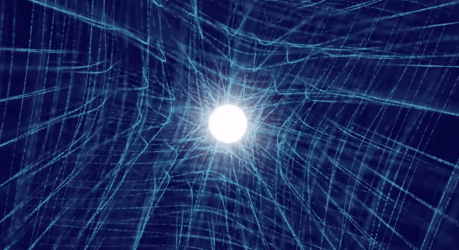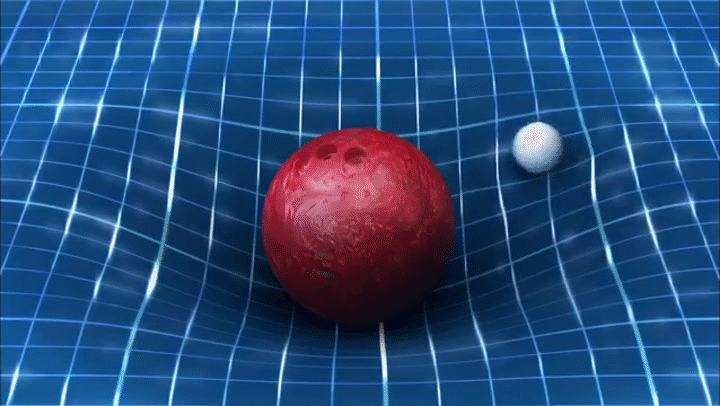General Relativity and Gravity

Einstein’s general theory of relativity can be summed up in just 12 words: “Space-time tells matter how to move; matter tells space-time how to curve”.
But this short description from the physicist John Wheeler hides a more complex and profound truth. Besides quantum theory, general relativity is one of two pillars of modern physics – our working theory of gravity and of the very large, of planets, galaxies and the universe as a whole. It is an extension of Einstein’s special theory of relativity – but such a massive one that it took him 10 years, from 1905 to 1915, to get from one to the other.
Special relativity tells us motion warps space and time. Einstein’s central coup with general relativity was to combine that with a principle noted over three centuries earlier by Galileo: that falling objects accelerated at the same rate regardless of their mass. Famously, a feather and a hammer dropped from the Leaning Tower of Pisa will hit the ground at the same time, once you discount air resistance. (During the Apollo 15 lunar landing in 1971, astronaut David Scott confirmed this principle on the airless moon.)
Following Galileo, Isaac Newton showed that this could only be true if an odd coincidence held: inertial mass, which quantifies a body’s resistance to acceleration, must always equal gravitational mass, which quantifies a body’s response to gravity. There is no obvious reason why this should be so, yet no experiment has ever prised these two quantities apart.
In the same way that he had used light’s constant speed to construct the special theory of relativity, Einstein declared this a principle of nature: the equivalence principle. Armed with this and a new conception of space and time as an interwoven “space-time”, you can construct a picture in which gravity is just a form of acceleration. Massive objects bend space-time around them, making things appear to accelerate towards them.
That explains why we feel a downwards pull towards Earth and why Earth orbits the sun. Although gravity is dominant over large cosmic scales and near very large masses like planets or stars, it’s actually by far the weakest of the four known forces of nature – and the only one not explained by quantum theory.
Take our expert-led online general relativity course to discover more about Einstein’s seminal idea
Quantum theory and general relativity in fact don’t get along at all. The two theories generally work at very different scales, so that’s not a huge problem. But it prevents us from understanding what happened in the very earliest instants of the big bang, for example, when the universe was very small and gravity was very strong. And in another situation where the two clash – at the event horizon of a black hole – unresolvable paradoxes emerge.
The great hope is that some “theory of everything” might one day unify quantum theory and general relativity – although attempts such as string theory and loop quantum gravity have so far failed to come up with the goods.
Meanwhile general relativity has never been found lacking. Its prediction that very dense agglomerations of mass could warp space-time so much that not even light could escape from it has proved to be true. We now call these objects “black holes”, can photograph the “event horizons” that surround them, and are pretty confident there’s one to be found at the centre of every massive galaxy.
But perhaps the biggest triumph of general relativity came in 2015, with the discovery of gravitational waves – ripples in space-time caused by the movement of very massive objects. The signal of two black holes spiralling together and merging was a triumph of painstaking, patient detective work by the Advanced LIGO experiment.
Gravity
An apple falls from a tree. A planet orbits its sun. You labour your bicycle up a hill, and accelerate smoothly down the other side. All those things are down to gravity, working exactly as Isaac Newton said it did almost three and a half centuries ago: a force that tells massive objects how to move.
Newton’s universal law of gravitation, formulated in his great work of mathematical physics, the Principia, published in 1687, was the first great work of force unification in physics. It tells us that many disparate phenomena, from falling apples to orbiting planets, all occur because massive objects experience an attraction between them that follows a set formula. The size of the gravitational attraction between two bodies increases in proportion with their masses, diminishes with the square of the distance between them, and has an absolute value ultimately determined by a universal, fundamental constant of nature, the gravitational constant or “Big G”.
For all its seeming universality, however, gravity is actually by far the weakest of the four known fundamental forces of nature. The only reason it appears to be so overwhelmingly strong in our neck of the woods is the local presence of an overwhelmingly large mass, Earth, beneath our feet that attracts them, and everything else, downwards towards it. It is the presence of large clumps of mass all over the universe, that ensures it determines how the universe works on a grand scale, on the level of planets, galaxies and clusters of galaxies.
As effective as Newton’s description is for most purposes, there is something mysterious about it, however. The way gravity seems to act instantaneously over great distances, even across half the universe, bothered Newton himself no end. He thought this “so great an Absurdity that I believe no Man who has in philosophical Matters a competent Faculty of thinking can ever fall into it”.
And indeed it turns out Newton’s theory is far from the last word on gravity. Einstein’s general theory of relativity, formulated in 1916, rewrites gravity as a property not of individual bodies, but of the universe as a whole. Gravity is just geometry, the result of the curvature by massive objects of the space and time around them. The strength of the gravitational “field” at any point in space or time is just the degree to which that coordinate in space-time is invisibly curved. Massive objects fall down these curves towards each other.
That depiction may not seem any less absurd than Newton’s, but it has passed every test thrown at it so far. It means that gravity stands apart from the other three fundamental forces, electromagnetism and the strong and weak nuclear forces, which are quantum forces, described by quantum field theory and transmitted by quantum particles.
The hope is that one day gravity might be too, when in a third iteration we uncover what quantum properties of mass, energy, space and time combine to make gravity at a fundamental level. At the moment, however, the quantum particle that transmits gravity, the “graviton”, remains stubbornly hypothetical – and with it the holy grail of a quantum theory of gravity.
And gravity remains on many levels fundamentally mysterious. Why is it so weak compared with the other forces? Why does it only pull, not push? And why is the strength of “Big G” (whose value is, incidentally, notoriously difficult to pin down) so apparently finely tuned to allow life to emerge? If it were just a little less, the expansion of space would have overwhelmed the pull of gravity on matter in the newborn universe, stars and galaxies would never have formed. If if were just a little more, any wannabe stars or galaxies would quickly have collapsed in on themselves and each other, while space-time would have folded up the whole universe in a big crunch. We have a lot to thank for gravity being like it is.
































